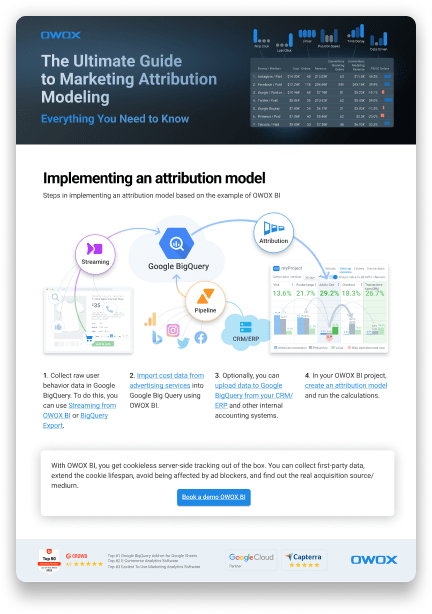What attribution means in marketing
Vlada Malysheva, Creative Writer @ OWOX
According to Gartner, more than two-thirds of the average advertising budget is dedicated to online channels. Any company that invests significant money in advertising campaigns suspects that not all these investments are profitable. Therefore, companies are beginning to wonder how to assess the effectiveness of investments in online and offline marketing.
In this article, we look at what attribution is in marketing, how it helps companies, and what mistakes and difficulties marketers and analysts typically encounter when working with attribution.
Note: This post was originally published in 2019 and was completely updated in October 2023 for accuracy and comprehensiveness.

Maximize Your ROI Now!
Schedule your strategy session.
What is the marketing attribution?
Marketing attribution is the process of determining which marketing activities or touchpoints contribute to a desired outcome, such as a sale or a lead, and assigning a value to each of these touchpoints.
The goal of attribution is to understand which marketing channels, campaigns, or efforts are the most effective in driving conversions so that marketers can optimize their strategies and allocate resources more efficiently.
‘‘An attribution model in web analytics is a set of rules that define each channel’s contribution to sales or other targeted actions.”
Vlad Flaks,
CEO, OWOX
According to this Ad Roll report, four out of five companies in Europe, North America, and Asia use attribution in marketing, and 51% of organizations consider attribution the most important part of marketing. The marketing attribution software market is expected to grow from 1.8 billion USD in 2023 to 4.6 billion USD in 2030.
Why use marketing attribution
In the ideal world, customers would buy immediately after viewing ads for the first time. Here is what the sales process might look like:
You Show the ad - You Make an Offer - You Sell
That’s it.
But, in reality, however, things are significantly more complicated.
Let us give you a quick real-life example from a non-digital world, we call it a Pizza Funnel.
You are probably familiar with an AIDA model (Awareness, Interest, Desire and Action).
Let’s imagine a person, that is driving down the highway when he spots a hilarious billboard advertising a new brand of pizza. It catches his attention, and he makes a mental note to try it out one day.
So stage #1 of the “pizza funnel” is The Billboard Encounter, also known as Awareness.
A few days later, the person overhears his colleagues raving about the same pizza brand during a casual conversation at the office water cooler. Intrigued by their enthusiastic reviews, the person decides to give it a shot.
This stage #2 is known as Interest or The Office Water Cooler.
After a long day at work, the person finds himself in the depths of hunger and decides it's time to order some food. He remembers the billboard and the water cooler conversation and chooses the pizza brand he has been hearing about.
This stage #3 is The Hungry Breakdown also known as a Desire.
Stage #4 of our “pizza funnel” is The Pizza Delivery: The pizza arrives, and as the person opens the box, he’s greeted by the most delicious-looking pizza he has ever seen. He takes a bite and instantly falls in love with the cheesy goodness.
This stage is known as Action or Conversion.
Stage #5 The Pizza Party: The person's taste buds are forever changed, and he becomes a raving fan of the pizza brand.
He started hosting pizza parties at his place, inviting friends and family to share in the pizza from the delivery. This stage is known as Loyalty or Retention.
But how do you know which advertising channels and campaigns work best and at what stage of the funnel?
Attribution helps you figure this out
By knowing the value of each session, you can calculate the value of campaigns, taking into account their contribution to the user’s promotion through the funnel..
So who gets the attribution credit?
The billboard?
Or maybe the colleague talking about the pizza near the cooler?
Or maybe the hunger?
Or the previous tasty pizza that led to a big party order?
The different touchpoints along the way, such as the water cooler conversation and the delicious pizza itself, contribute to the attribution of the customer's decision to become a loyal customer.
The data scientist would probably say that it should be distributed with some proportion.
But what is that proportion?
Who should be getting the credit and what should be the distribution?
Here is the list of reasons that make the sales process more complicated:
Lack of familiarity with the brand — The customer sees an ad, follows the link to the site, and signs up for the newsletter. Then they get distracted and close the site.
Lack of purchase thought process (conversion window) — The customer selects a product, looks at reviews, and compares items. At the same time, they receive a newsletter from the company and see advertising on social networks (for example, Facebook, Instagram, and Twitter).
Purchase (conversion) — The customer returns to the site (the transition can be direct, via a saved link, from an advertising channel, or from organic search) and finally makes a purchase.
Re-purchase (customer retention) — For this purpose, companies often use remarketing and remind customers about their products through emails and social media posts.
What are the typical questions that attribution helps marketers to answer?
First, you’ll be able to figure out which marketing channels led to the highest number of conversions.
Second, which is more important, How to re-distribute or increase ad spend to get more sales. Because at the end of the day, every business is about getting more sales and making more money.
Third, what might be the improvements or recommendations for future ad campaigns?
And #4, are there any gaps in the customer journey that you need to fix?
Attribution Models
But what is the right model to get those questions answered?
By choosing the correct model for your company, you’ll see how you need to allocate your advertising budget to enhance ROAS. Accordingly, this will help you increase revenue and reduce costs.
There are more than a dozen attribution models that can be divided into the following categories:
Single-channel models
This group of attribution models gives all the credit to the first or last touchpoint before the conversion. It's the most straightforward method that could oversimplify the customer journey. Here is the list of single-channel attribution models:
Let’s look at a quick example:
Jane was looking for a new pair of running shoes. Her journey to purchase was as follows:
Day 1: Jane sees a Facebook ad for a shoe store and clicks on it to browse, but doesn't make a purchase.
Day 3: She receives an email newsletter from the same store showcasing a new collection of running shoes.
Day 5: Jane searches Google for "best running shoes" and clicks on a Google Ad for the same shoe store.
Day 10: She finally makes a purchase after clicking on a retargeting ad she sees while reading an article on a news website.
In the example above, the remarketing ad would get 100% of the credit for Jane’s purchase - if the company was using Last Click attribution.
If the company was using first-click attribution, 100% credit would go to the Facebook Ad that Jane saw on Day 1.
Multi-channel models
Multi-channel attribution is more sophisticated than single-channel attribution. The model recognizes the role of multiple channels in ensuring the final sale. Here is the list of standard multi-channel attribution models
Going back to Jane’s example, Linear attribution would assign 25% credit to each of the 4 channels that she encountered.
On the contrary, time decay attribution assigns more credit to channels that are closer to the time of conversion. In other words, most credit would go to the retargeting ad and least credit would go to the Facebook ad.
Position-based attribution, also known as the U-shaped attribution model, is a method that assigns credit for a conversion based on the position of a touchpoint in the customer journey.
This model typically gives more weight to the first and last interactions, with the remaining credit distributed evenly among the middle touchpoints.A common distribution in the U-shaped model is:
40% of the credit to the first touchpoint (for introducing the customer to the brand or product).
40% of the credit to the last touchpoint (for sealing the deal).
The remaining 20% is distributed evenly among any middle touchpoints.
Algorithmic
Algorithmic attribution models leverage advanced statistical, probabilistic, and machine learning techniques to assign credit to different touchpoints in a customer's journey. Here's a brief explanation of each:
Data-Driven Attribution: Uses historical data to determine the impact of touchpoints on conversions, analyzing which channels are most influential.
Markov Chains: A probabilistic model that views the customer journey as transitions between touchpoints, calculating the importance of each by simulating its removal's effect on conversions.
Machine-learning Funnel-based Attribution: Employs machine learning to analyze the customer journey, adjusting credit based on observed influence on outcomes.
Shapley Value: From game theory, it distributes the conversion's "value" among touchpoints based on their average contribution to all possible touchpoint combinations.
Note: You can find a detailed comparison of different attribution models in one of our previous articles.
If you want to discover the real contribution of advertising campaigns to your marketing success - then explore Machine Learning Funnel-Based attribution, which distributes value based on each channel’s influence on a user’s movement through the sales funnel - with OWOX BI!
Problems with attribution
According to Ad Roll research, 59% of companies have tried to work with attribution but stopped due to a lack of knowledge. In reality, most marketers have little understanding of it and have difficulty working with it. A report by Ad Roll also indicates that 70% of companies find it difficult to properly use insights obtained from attribution data. And this is why:
More than 35% of companies cannot correctly determine customer touchpoints. For successful work, you need to evaluate all the channels involved. And given the omnichannel nature of marketing, it’s quite difficult to control every channel.The fact that one person often uses different devices also adds complexity. On the one hand, such a network of connected devices presents opportunities for marketers. On the other hand, how can you track all of this?
However, there are other difficulties when working with attribution:
Manually collecting data from different advertising platforms. You need to know hundreds of nuances about how to correctly download data from each service and how to consolidate it in a uniform database.
The market demands synchronous changes to existing models. Outdated models just can’t adapt to new business requirements.
Fixed budgets and partner contracts with the same advertising agencies make it hard to quickly change strategies. Besides, it’s necessary to consider the time spent assessing marketing efforts, searching for and interpreting insights, and developing a strategy for improving campaigns.
Privacy & tracking limitations: The privacy settings of platforms like iOS have significant implications for marketing attribution:
- User Tracking Limitations: Apple's App Tracking Transparency (ATT) requires apps to seek user permission for cross-app tracking, leading to fewer data points for marketers.
- Aggregated Data: Privacy measures often provide data in aggregated forms (eg. data sampling in Google Analytics 4), reducing detail and making precise attribution harder.
- Delayed Reporting: Privacy settings can introduce data reporting lags, affecting real-time marketing decisions.
- Shift to First-Party Data: With third-party tracking reduced, marketers lean more on direct data collection, though it may not capture the full user journey.
- Alternative Attribution: Privacy constraints push marketers towards methods like probabilistic attribution, which estimates behavior from aggregated data.
As you can see, there are enough difficulties in applying attribution. However, this doesn’t mean you should avoid it. Because with one, you can take marketing to a new level.
Benefits of attribution
Despite the difficulties in creating an attribution model, its purpose is very simple – to assess the effectiveness of advertising channels. With the results of this assessment, you can determine how efficiently you spend your advertising budget.Key benefits of attribution:
Improved personalization. Derived insights can be used for more effective advertising.
Increased ROI/ROAS. The correct model helps marketers know which channels and channel bundles are the most efficient so they can redistribute the budget and increase conversions and ROI.
With attribution, you can see value from both channels that bring in regular customers and channels that bring in new users.
To avoid difficulties in working, it’s first necessary to exclude manual work with data & improve tracking accuracy. OWOX BI helps you gather all information from your various sources in one place, prepare your data for automated reporting, and build accurate reports in minutes.
Configuring a standard or algorithmic attribution model in OWOX BI does not require any in-depth technical knowledge so you can get it set up in minutes.
And if you need the help of an expert data engineer to build a custom attribution solution for your needs OWOX team is here to help you.
Key takeaways
You don’t have to start with advanced attribution models that require a lot of time and investment. You can use services like OWOX BI to select the model that suits your needs.
Don’t forget what’s important: attribution helps you effectively redistribute your marketing budget.
Consider not only the marketing team but also sales and customer support. Doing so will make it clearer to you not only what to evaluate but how.
Don’t rely on a long-standing model. To succeed in today’s market, you should use a model that considers your marketing and business needs in evaluating channels.
FAQ
-
What is attribution?
Attribution is the distribution of value from a conversion between channels that advanced the user through the funnel. It helps answer to what extent each channel influenced the user’s promotion through the funnel and the revenue you received in the end. -
What does attribution mean in marketing?
Attribution is the distribution of the conversion value among campaigns that encouraged the user through the funnel. It helps to answer to what extent each channel influenced the conversion. -
What are different attribution models?
There are dozens of possible attribution models. They can be classified in different ways depending on the logic used in their calculations.
If we look at what place a channel occupied in the customer journey before the order, then we’re using an attribution model based on position (Time Decay, Position-Based). If the calculation takes into account all data and not only the position of the channel in the chain, then it’s an algorithmic attribution model (Data-Driven, Markov chains).
If we give all the value to only one channel that participated in the funnel, then it’s a single-channel model (Last Click, First Click). If the value is distributed among all channels in the chain, then it’s a multi-channel attribution model (Linear, Time Decay). -
What does attribution mean in advertising?
The goal of attribution in advertising is to define how the value of a conversion is distributed across channels that move the user through the funnel. -
How do I choose the right attribution model for my business?
You can choose the right attribution model for your business based on the behavior of your customers, the complexity of your sales funnel, and your business goals.













